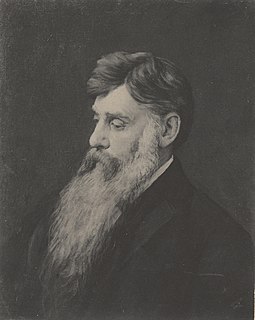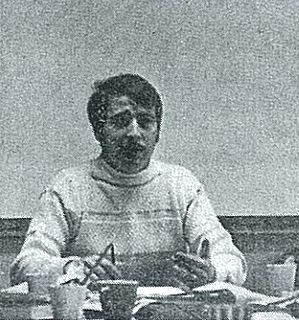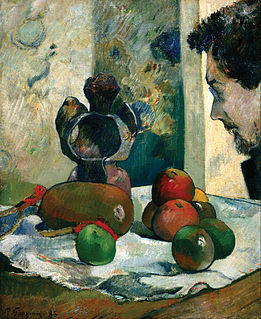
George Inness was a prominent American landscape painter.

Frederic Edwin Church was an American landscape painter born in Hartford, Connecticut. He was a central figure in the Hudson River School of American landscape painters, best known for painting large landscapes, often depicting mountains, waterfalls, and sunsets. Church's paintings put an emphasis on realistic detail, dramatic light, and panoramic views. He debuted some of his major works in single-painting exhibitions to a paying and often enthralled audience in New York City. In his prime, he was one of the most famous painters in the United States.

The Barbizon school of painters were part of an art movement towards Realism in art, which arose in the context of the dominant Romantic Movement of the time. The Barbizon school was active roughly from 1830 through 1870. It takes its name from the village of Barbizon, France, on the edge of the Forest of Fontainebleau, where many of the artists gathered. Most of their works were landscape painting, but several of them also painted landscapes with farmworkers, and genre scenes of village life. Some of the most prominent features of this school are its tonal qualities, color, loose brushwork, and softness of form.

The Hudson River School was a mid-19th century American art movement embodied by a group of landscape painters whose aesthetic vision was influenced by Romanticism. The paintings typically depict the Hudson River Valley and the surrounding area, including the Catskill, Adirondack, and White Mountains. Works by the second generation of artists associated with the school expanded to include other locales in New England, the Maritimes, the American West, and South America.

Asher Brown Durand was an American painter of the Hudson River School.

Samuel Colman was an American painter, interior designer, and writer, probably best remembered for his paintings of the Hudson River.

Alexander Helwig Wyant was an American landscape painter. His early works belonged to the Hudson River School, with its direct pastoral narrative, but evolved into the more moody and shadowy Tonalism. After a stroke which paralysed his right arm, he taught himself to paint with his left.

Robert Seldon Duncanson was a 19th-century American landscapist of European and African ancestry. Inspired by famous American landscape artists like Thomas Cole, Duncanson created renowned landscape paintings and is considered a second generation Hudson River School artist. Duncanson spent the majority of his career in Cincinnati, Ohio and helped develop the Ohio River Valley landscape tradition. As a free black man in antebellum America, Duncanson engaged the abolitionist community in America and England to support and promote his work. Duncanson is considered the first African-American artist to be internationally known. He operated in the cultural circles of Cincinnati, Detroit, Montreal, and London. The primary art historical debate centered on Duncanson concerns the role that contemporary racial issues played in his work. Some art historians, like Joseph D. Ketner, believe that Duncanson used racial metaphors in his artwork, while others, like Margaret Rose Vendryes, discourage viewers from approaching his art with a racialized perspective.

The Indianapolis Museum of Art (IMA) is an encyclopedic art museum located at Newfields, a 152-acre (62 ha) campus that also houses Lilly House, The Virginia B. Fairbanks Art & Nature Park: 100 Acres, the Gardens at Newfields, the Beer Garden, and more. It is located at the corner of North Michigan Road and West 38th Street, about three miles north of downtown Indianapolis, northwest of Crown Hill Cemetery. There are exhibitions, classes, tours, and events, many of which change seasonally. The entire campus and organization was previously referred to as the Indianapolis Museum of Art, but in 2017 the campus and organization were renamed "Newfields" to better reflect the breadth of offerings and venues. The "Indianapolis Museum of Art" now specifically refers to the main art museum building that acts as the cornerstone of the campus, as well as the legal name of the organization doing business as Newfields.

Mega-Gem is an outdoor sculpture by American artist John Francis Torreano. It is located on the Indiana University-Purdue University Indianapolis (IUPUI) campus, which is near downtown Indianapolis, Indiana, and is owned by the Indianapolis Museum of Art. The oversized sculpture, made of aluminum, is shaped like a round-cut diamond resting on one its facets and studded with 36 smaller, colored-metal rosettes.

Thomas Locker was an American landscape painter and award winning illustrator and author of Children's literature His oil paintings follow in the tradition of the 19th-century Hudson River School of painting.

The Boat Builders is an oil painting on panel by American landscape painter Winslow Homer, which is held in the collection of the Indianapolis Museum of Art (IMA), in Indianapolis, Indiana, United States.

The Fifth Plague of Egypt is an oil painting by Romantic English artist Joseph Mallord William Turner currently in the permanent collection at the Indianapolis Museum of Art. Despite its title, it depicts Moses cursing the Egyptians with a plague of hail and fire, known as the seventh plague.

Vorhor, the Green Wave is one of the most famous paintings by French artist Georges Lacombe. It is currently located in the Indianapolis Museum of Art, which is in Indianapolis, Indiana. Painted 1896-97, Lacombe used egg tempera and the inspiration of Japanese prints to depict the cliffs of Vorhor in Brittany.

The Channel of Gravelines, Petit Fort Philippe is a pointillist painting by French artist Georges Seurat, located in the Indianapolis Museum of Art in Indianapolis, Indiana. Painted in 1890, the year before his death, it depicts a harbor in the small French port of Gravelines. Described as "wistful and poetic," it is one of the treasures of the IMA.

Landscape near Arles is an 1888 oil painting by French artist Paul Gauguin depicting a rural scene in Provence. It is currently located in the Indianapolis Museum of Art in Indianapolis, Indiana.

Still Life with Profile of Laval is an 1886 oil painting by French artist Paul Gauguin, located in the Indianapolis Museum of Art, which is in Indianapolis, Indiana. It depicts Gauguin's friend Charles Laval in profile with an assortment of inanimate objects, including a ceramic pot Gauguin made himself.

The Banks of the Oise near Pontoise is an 1873 oil painting by French artist Camille Pissarro, located in the Indianapolis Museum of Art, which is in Indianapolis, Indiana. It depicts the river Oise near the market town of Pontoise.

The Flight into Egypt is a 1635 oil painting by French artist Claude Lorrain, located in the Indianapolis Museum of Art, which is in Indianapolis, Indiana. It depicts the Flight into Egypt, when the Holy Family fled to Egypt to escape Herod's persecution.

Niagara is an oil painting by Frederic Edwin Church. Niagara was his most important work to date, and confirmed his reputation as the premier American landscape painter of the time. In his history of Niagara Falls, Pierre Berton writes, "Of the hundreds of paintings made of Niagara, before Church and after him, this is by common consent the greatest."



















